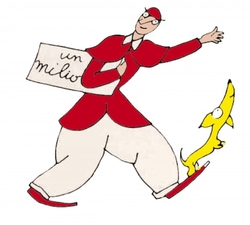Blog Archives
Italy: What Now?
I received this question, an ideal starting starting point, from the always very perceptive Catocon:
Mundabor,
where do Monti and this centrist coalition stand on the *really* important issues, that is, abortion, homosexual “marriage”, secularism etc…? My impression has been that he is what Europeans call a liberal, that is an economically moderate technocratic statist too timid to confront social issues but (if necessary) always a willing slave of the spirit of modernity. But my knowledge of Italian politics is certainly lacking, so maybe Italian “centrists” are different.How certain are we that those centrists will not start to “evolve” as it is called in Obama’s language, as “centrists” all over the West inevitably tend to do when the pressure from the media and the established cultural revolution starts to mount?
As I understand the Italian electoral system, the strongest party/coalition is guaranteed a majority of at least 54% in one chamber of parliament and also, on a regional basis, in the Senate, right? Any split between non-leftist coalitions would be utterly disastrous in that case as leftists could win a majority of seats even if they lost the election in terms of the popular vote because of the split in the non-leftist vote between “centrists” and “rightists”. To support any kind of centrist coalition just to avoid endorsing someone like Berlusconi would be utterly irresponsible in this case.
Does not the Church hierarchy, by throwing her weight behind the center coalition, effectively help secure a parliamentary majority for the socialists and communists on the left even if the center does turn out to be relatively solid on the issues that matter most to the Catholic?
In order to give a better idea of how I see things, I will divide the answer in several sections: how the system works, what the Vatican is trying to do and why, and whether we can trust the Catholic parties.
Keep in mind the situation is at the moment extremely fluid and fascinating, with a very mobile electorate. Also keep in mind hardcore Catholics are, for now, slowly dying.
At the Camera there is the majority premium Catocon describes: the strongest coalition gets 340 seats out of 615. It doesn’t matter if the strongest coalition only has, say, 20% of the votes. The coalition with the relative majority gets 340 members, period.
At the Senate there are 20 regions, and 17 of them get a (regional) majority premium. The biggest ones (like Lombardia, Lazio, Campania, Sicilia) are seen as crucial. Again, the premium here is regional, so there are several decks of cards to be distributed.
At the moment the field is divided in four major major camps, again with the situation extremely fluid and changing almost daily.
1. Left wing coalition.
They are the almost sure winner of the majority in the Camera. They will probably ally with the sodocommunists, though they don’t really like them. If the centre is strong (which it might well become) they will lose some parts on their right wing side (this is already happening), which makes the alliance with the sodocommunists the more important to them. The main component of this coalition supports Monti’s agenda, though the extreme left wing of the sodocommunists don’t. This might be a split in the making, with the two allying for the vote and to bag the majority premium, but splitting afterwards as the sodocommies do not support Monti’s austerity program. Together with the sodomites, this grouping is (for now) comfortably in the 30%-35% range. But they have a difficult job as this is the only coalition with divided loyalties concerning Monti and o one can say how many moderate elements will prefer the centre instead now that they have become a very credible alternative.
2. Right wing coalition
This is what is left of the old Berlusconi coalition who won big in 2008, after losing several pieces down the road. The Lega Nord appears not to want an agreement if Berlusconi wants to run as PM, but they would support the alliance is Berlusconi renounces to Prime Ministerial ambitions.
Neither Berlusconi nor the Lega support Monti. This attracts to them a lot of protest votes, but makes them invotabili for that part of the country committed to stop Italy from becoming the next Greece. They have a component of very tough Catholics, but their Catholic credentials aren’t considered the best as Berlusconi would only follow Catholic interests as long as they serve him and would throw his weight on the other side whenever necessary.
This coalition appeared dead in the water only two weeks ago. Berlusconi’s offensive is now causing them to strongly recover. Last time I looked they were given at 20%, trend ascending, even without the Lega. If you ask me, they are going to fish protest votes from Grillo’s voters (see below) like there’s no tomorrow.
Berlusconi has now also announced a strongly Catholic program, in preparation as I write. His aim is to make the Vatican lose credibility and rally around him the Catholic voices. Brilliant strategy as always (this man is around one thousand times smarter than the foreign press depicts him), but Berlusconi still has a credibility problem, and no Vatican endorsement.
3. Centre coalition.
This is the fiscally and (in large part) socially conservative coalition created to support Monti’s program. A strong Catholic party (UDC) is the backbone of the coalition, which is integrated by non-Catholic components. The loss of the UDC is what causes the second biggest headache for Berlusconi, the Lega being the first. This coalition gained the open support of the Vatican and is, literally, defying gravity, at 23% yesterday.
They are, as a coalition, purely focused on Monti’s program. But the UDC as a party is the safest bet for Catholics in Italy. The Vatican endorsement will take care that the coalition becomes more and more dominated by the Catholic element, but do not expect them to campaign as a coalition with Catholic values: they are there to support Monti’s economic program and they want their votes, whether Catholic or not. Still, Italians are sophisticated voters and many of the supporters of this coalition will be seen (or officially vote in the Camera; in the Senate there will be a unity list for complex reasons of minimum votes necessary) as staunch Catholics.
4. Grillo (Five Stars)
Grillo is a successful comedian with the hobby of politics; he has been creating a vast consensus around him, based on the usual refusal of professional politics and desire to reinvent the wheel such protest movements always have. He is an enemy of Monti and of everything that is unpopular and difficult to bring to the masses; as always, his message appeals to the dissatisfied, the disaffected, the undecided, the irresponsible and the plain stupid. They used to be very strong months ago, when Berlusconi’s party officially (if begrudgingly) supported Monti, and they were even given as the biggest single party (not coalition) out there. If you ask me, they will have a tough time now that the populist position is covered by the Right Wing coalition. They could end up massacred, or else the second or third biggest coalition. At the moment, no one knows.
—————-
Cardinal Bagnasco, the head of the Italian Bishops’ conference, threw Berlusconi out of the window in 2011 and never fished him in again. I have already written on this blog I do not know how wise this was, but their reasoning is that it is for the right-wing coalition to get rid of Berlusconi, rather than for the Vatican to have to support Berlusconi no matter what. In fact, in Italy you are traditionally expected to listen to the Vatican rather than expect them to listen to you, as they are (for now) powerful enough to demand it. Again, Ruini swallowed Berlusconi’s toad for many years, but Bagnasco (a rather tough guy particularly compared to Ruini) has decided that enough is enough and there will be no turning back.
How powerful the Vatican (still) is can be seen in the “centre” coalition now given (last time I looked, that is: yesterday) at an astonishing 23%. Mind, these votes aren’t transferable 1 to 1 to a centre-right coalition, as a good part of the country will never vote Berlusconi anyway. By refusing to support Monti’s course, Berlusconi has chosen the populist and protest vote, but he will emphatically not get the moderate conservative vote; certainly not now that the Vatican says to vote centre, but it is clear many of them would have never voted for Berlusconi anyway.
I think Bagnasco & Co. consider the winning of the majority premium from the left side inevitable, as does the entire country. By supporting Berlusconi (largely seen as the losing camp, and irremediably opposed to the left) there is a concrete risk of leaving the left with two majorities, and a sodomarriage of sort would follow (probably) rather fast after that.
On the other hand, by trying to “defy gravity” and put all their weight behind a strong centrist coalition, the Vatican aims at warping the leftist bid for double majority, as the centre coalition amputates them on their right wing side. If they manage to thwart a left-wing majority in the Senate, which is the real name of the game, they are very probably safe against any sodomite legislation without having to marry Berlusconi’s populism, opportunism and corruption. The rallying cry of the Curia should help the centre reach critical mass instead of being massacred in the middle of the opposing left and right wing blocks. I call this “defying gravity” because what is happening now is unprecedented in the history of the new electoral system, which is designed to divide the country around two big blocks of centre-left and centre-right. Small parties have always survived (or not) as independent, but never was a big “third” coalition seen to have any chance.
The centre and the right are now fighting for the soul of the (moderate) country: they will not work together because the right is now a kind of populist “protest party” whose Weltanschauung is at odds with the fiscally responsible centre. Still, whilst you can’t unite their votes to make a government, you can unite them to avoid sodomite legislation. It everything goes according to plan, this will be an insurmountable barrier at least in the Senate.
As to the Catholic parties, be not afraid: they are very different from the CDU, or from the CSU come to that. The UDC voters have been in these twenty years such a steady element that it is utterly irrelevant whether their leaders would want to sell themselves: they won’t, because they know it would very probably be their death. As I see it, no “evolving” is to be feared from that side, rather the contrary… What Germans (and Brits of Americans) needs to understand here is that a core of hardline Catholics (perhaps 10-14% of the voters, now divided between right and centre, formerly between centre-left and centre-right) are real Catholics who have up to now always successfully gone on the barricades when necessary. They are square in the middle and they are still seen as the key to power, which is why the moderate leftists don’t want to anger them and Berlusconi wants their votes so badly.
I will, unless something huge happens, vote for the UDC myself. Not so much because Bagnasco says so, but because I think that in Italy you will not find another party you can thrust so much to defend Catholic values, and which such a good chance of your vote truly being put to work against the Left. I might be wrong of course, but as far as the Catholic vote is concerned I wasn’t these last twenty years. Italy is a country where people were ready to even vote for Berlusconi merely because he defended Catholic values (they actually voted Catholics components and candidates within his coalitions) and I can’t imagine any other European country ready to swallow so much for the cause.
As I see it (and the Vatican seems to agree with me.. 😉 ) the centre coalition is the wedge pushed in the middle of an otherwise probably unavoidable double majority for the left-wing. They have pooped in the leftist party, and if everything goes according to plan they will be the elephant in the room without which no majority – much less sodomite legislation – is possible.
Once again – and to conclude – the votes of the populist right wing and of the Monti coalition can’t be added, as the fiscal differences can’t be bridged. It will have to be the one or the other.
The Vatican has chosen the “other”. I think it’s the wiser bet.
Mundabor





















You must be logged in to post a comment.